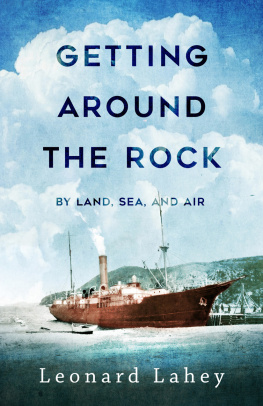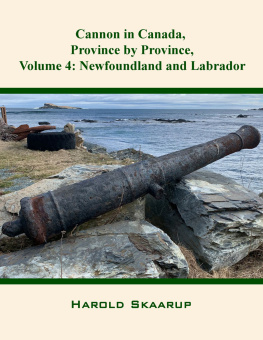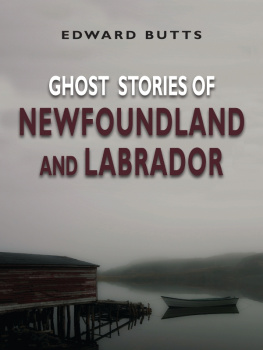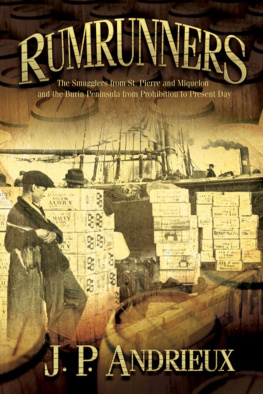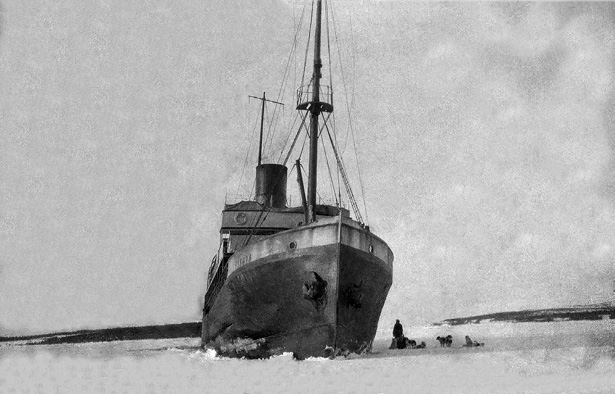
Getting Around
the Rock
_______________________________________
by land, sea, and air
Leonard Lahey
Flanker Press Limited
St. Johns
Library and Archives Canada Cataloguing in Publication
Lahey, Leonard, author
Getting around the rock : by land, sea, and air : stories of
transportation in Newfoundland / Leonard Lahey.
Issued in print and electronic formats.
ISBN 978-1-77117-520-3 (paperback).--ISBN 978-1-77117-521-0 (html).--
ISBN 978-1-77117-522-7 (html).--ISBN 978-1-77117-523-4 (pdf)
1. Transportation--Newfoundland and Labrador--History.
2. Newfoundland and Labrador--Biography. I. Title.
HE215.Z7N44 2016 388.09718 C2016-900201-2
C2016-900202-
2016 by Leonard Lahey
All Rights Reserved. No part of the work covered by the copyright hereon may be reproduced or used in any form or by any meansgraphic, electronic or mechanicalwithout the written permission of the publisher. Any request for photocopying, recording, taping, or information storage and retrieval systems of any part of this book shall be directed to Access Copyright, The Canadian Copyright Licensing Agency, 1 Yonge Street, Suite 800, Toronto, ON M5E 1E5. This applies to classroom use as well. For an Access Copyright licence, visit www.accesscopyright.ca or call toll-free to 1-800-893-5777.
Printed in Canada
Cover Design by Graham Blair
Flanker Press Ltd.
PO Box 2522, Station C
St. Johns, NL
Canada
Telephone: (709) 739-4477 Fax: (709) 739-4420 Toll-free: 1-866-739-4420
www.flankerpress.com
9 8 7 6 5 4 3 2 1

We acknowledge the [financial] support of the Government of Canada. Nous reconnaissons lappui [financier] du gouvernement du Canada. We acknowledge the support of the Canada Council for the Arts, which last year invested $153 million to bring the arts to Canadians throughout the country. Nous remercions le Conseil des arts du Canada de son soutien. Lan dernier, le Conseil a investi 153 millions de dollars pour mettre de lart dans la vie des Canadiennes et des Canadiens de tout le pays. We acknowledge the financial support of the Government of Newfoundland and Labrador, Department of Tourism, Culture and Recreation for our publishing activities.
This book is lovingly dedicated to my wife, Linda, my sons, Craig, Kurt, and Keith, my daughters-in-law, Brooke and Krista, and my grandchildren, Rayne, Alena, Olivia, and Benjamin.
For new generations with Newfoundland roots, may this be a record of their heritage.
Acknowledgements
Much appreciation goes to my wife, Linda, for her patience and understanding, and to my brothers, Ray and Bill, for all their help and support, particularly for their editing skills.
Thanks to Andy Christensen, for generously supplying some of the photographs used here. Also to Margaret Walsh Parsons, for identifying some of the Walsh family in the photograph of the Reid Newfoundland Railway Station, Bishops Falls.
To Stewart Green and Mark Linney for their help in identifying various aircraft and military uniforms, many thanks.
To Gordon Barnes and Annette Hurley at the Railway Coastal Museum for their help in trying to identify some of the early Reid family, and to the many people in various archives and museums who so freely shared their time and knowledge, I thank you.
CONTENTS
Introduction
Some Family Reminiscences
This is a collection of stories dealing with the history of the transportation sector, largely in pre-Confederation Newfoundland and Labrador. Throughout the book I make reference to Newfoundland, which was at the time the provinces official name. The stories come from recollections passed on to me by both my father and my uncle, who spent the whole of their working lives in the changing times of transportation and communications in the province.
William (Bill) Joseph Lahey was the main source of inspiration for this book. The book represents his personal account of events from this time period and shows his involvement in three varied sectors of transportation, an involvement which was in part paralleled by my father, Raymond (Ray) Lahey, although my dad spent his whole working life with various incarnations of the Newfoundland Railway.
My uncle Bill was born in South Dildo, Trinity Bay, a tiny community at the very head of the bay, on September 2, 1901. His parents were Captain William Lahey and Mary Anne Emberley. He was christened William Joseph Lahey, named in the Irish tradition after his father and grandfather. Like most people in Trinity Bay, Bills family was involved with the fishery. His father, who operated the fishing schooner Bellows for his own father-in-law, most often on the Labrador Coast, contracted tuberculosis during the autumn of 1902 and died in early January 1903 at the age of twenty-nine, leaving Bill an orphan, and his mother, Mary Anne (Minnie), pregnant with her second son, Raymond.
Bill went to live nearby on the fishing/farming premises of his grandparents, William and Maggie Emberley, on Brazils Road. In their younger days, he and his brother were educated at various denominational schools in the area, including the Anglican schools in South Dildo and Spread Eagle, as well as in the Anglican and Salvation Army schools in Blaketown. Bill remembered the holiday in the Anglican school in Blaketown when King Edward VII died on May 6, 1910. Uncle Bill also attended the Anglican school in Old Shop. Some of his early teachers were Susie Hunt in South Dildo, Jacob (Jake) Morgan in Blaketown (father of Dr. Moses O. Morgan, president of Memorial University 19731981), and Edwin Charles, Abram, and Lewis Parrott, three brothers from New Perlican who taught in Old Shop. Another well-known Newfoundlander both boys had as their childhood friend was William J. Lundrigan, who along with his future wife, Naomi Dawe, attended the same small school with Bill and Ray in Blaketown, and who in time, with his son Arthur, formed the huge Newfoundland construction, engineering, and manufacturing company W. J. Lundrigan Limited.
Both my uncle Bill and my father began their working careers with the Reid Newfoundland Company as apprentices by learning telegraphy in nearby New Harbour, then on a railway branch line. My uncle Bills first posting with the railroad was in St. Georges, on the west coast of the province. Later, in 1919, he was transferred to Hearts Content. Already proficient in Morse code from his railway work, it was here he decided to apply for a course with Canadian Marconi to learn wireless telegraphy.
As a successful candidate with Canadian Marconi, Bill was transferred to Quebec City. As an employee of Canadian Marconi, he later worked in Clarke City, Sept-les, Cape Race, and also Cape Harrison, Labrador. By 1923, he was working as a wireless operator on the Newfoundland coastal boats. Some of the steamers on which he served included the SS Argyle , the SS Portia , the SS Prospero , the SS Meigle , the SS Imogene , the SS Sebastopol , and the SS Kyle . He was aboard the SS Meigle in 1929 when it was sent to the south coast to aid the victims of the tsunami. The following month, the crew spent two weeks searching for missing schooners, one of which was the Neptune II , operated by Captain Job Barbour, who later wrote his adventures in Forty-Eight Days Adrift .
Bill was also wireless operator aboard the SS Sagona in March 1931, when it was sent to rescue the survivors of the Viking disaster.

